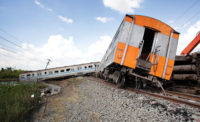Safety gets delayed (again)
Rail lines get 3-5 years to install new braking system

Congress in October gave the nation’s railroads three more years, and possibly up to five, to install a mandated safety system that would automatically slow trains running at unsafe speeds, and which safety experts say could have prevented May’s fatal Amtrak derailment in Philadelphia.
So safety gets pushed back, delayed, put off, one more time.
It is shamefully and frustratingly something that is anything but precedent-setting.
How many workplace safety investments are postponed and/or ignored until there’s a serious injury or fatality? Then the owner, a corporate VP, plant manager, or some exec gets born again. They vow never again to make a phone call to a victim’s family. And suddenly the budget for safety is there.
I’m not telling you anything you don’t already know and likely have experienced, but too many businesses – in mining, construction, oil and gas extraction, chemical processing – you name the industry – drag their feet on investing in safety improvements. It’s about money of course, resource allocation, the bottom line, short-term mindsets and behaviors.
Delaying compliance
If more companies committed hard dollars to safety improvements I don’t believe we would see the exact same ten most-frequently-cited OSHA standards publicized year after year. The top ten for fiscal year 2015 are identical to the lists for fiscals 2014, 2013, 2012, 2011 and 2010.
Here’s another sign of how too many companies delay compliance: five of those top ten standards causing industry and construction the most problems are more than 20 years old. Three more are at least 15 years old. Despite being on the books for 15-20 years, widespread compliance violations persist.
More breathing space
Back to the railroad industry — positive train control, which can remotely put the brakes on speeding trains, was supposed to be installed on major passenger and freight lines by the end of 2015. Only a handful of commuter railroads and no freight lines said they could meet the deadline.
Now they have breathing room. Rails will have at least until December, 31, 2018, with the potential for extensions up to the end of 2020, to put into place positive train control. You know there will be more crashes, injuries, perhaps fatalities, and near misses during this “grace” period.
Familiar plot line
The narrative here is depressingly repetitious. The new deadline was lobbied for by railroads and opposed by safety advocates. Nothing new there. Railroads said the original deadline was unrealistic and they claim to have been slow to comply due to budget shortfalls and technical issues.
This same argument often undermines the traditional hierarchy of safety controls. Engineering controls, the preferred number one option, are too often seen as not feasible — economically, technically or both. Option two, administrative controls, such as rotating employees through physically demanding work or providing rest breaks, is argued to be too costly, too time-consuming, too disruptive and too paperwork-heavy. Don’t tramp on a business’s right to organize work the best way it sees fit. So the last option in the hierarchy — personal protective equipment (PPE) — becomes the go-to play. PPE is generally a less expense route. But if comfort, fit, style, training and supervision are all not invested in, PPE compliance can and does suffer.
Safety brinksmanship
To be sure, it’s reported freight lines have spent about $6 billion on train control systems. It’s not as though the industry is thumbing its nose at this safety system. Still, despite the billions, no freight line will have the system in place by year end. And to make their situation perfectly clear, some freight and commuter lines warned that they might have to cease operations without a compliance extension.
We’ve heard that threat for decades. Former Labor Secretary Robert Reich back in the early 1990s took great pride once in heavily penalizing a company, getting personally involved in the case, only to be stunned when company owners said, in effect, OK if that’s the way you want to play hardball, we’re closing the plant. Out on the streets will go hundreds of employees. Call it safety brinksmanship. The game’s been played since the day OSHA began inspecting worksites and levying fines.
Safety stall ball
Here’s the kicker to the railroad safety tale: The National Transportation Safety Board has called for installment of positive train control since 1970 – 45 years ago. Call it crying in the wilderness, or a safety pro predicting trouble, voicing concerns and the need to act, and having his or her words echo off the walls of an isolated safety silo.
The NTSB estimates the positive train system could have prevented 140 accidents that resulted in nearly 300 fatalities since 1970. When it takes OSHA 10-15 or more years to set a standard, the same bloody price is paid. Call it safety stall-ball. It happens globally, it happens locally.
Sen. Barbara Boxer (D-CA), who helped set the positive train control deadline seven years ago in 2008, blasted the extension. That’s what advocates do – blast away, sound and fury producing usually nothing. Supporters of the extension expressed relief that a possible rail shutdown -- with what they claimed would be devastating economic consequences -- had been avoided. Companies let off the hook would prefer to talk about those calamitous economic burdens avoided. And of course the newly-confirmed head of the Federal Rail Administration said all the right things in a recent speech. Make the goal. Beat the deadline. The public deserves it. What else is a top official or corporate exec going to say after a fatal accident?
This delay in investing in necessary and life-saving safety technology brings to mind what the late, great Yogi Berra said: “It’s déjà vu all over again.”
Looking for a reprint of this article?
From high-res PDFs to custom plaques, order your copy today!









